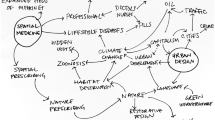Abstract
Recent rapid urbanization is associated with increased stress and reduced sense of well-being. The environment where one lives, works, learns and plays affects us. Overwhelming research now links nature contact with positive mental and physical health and social outcomes. Healing landscapes provide the necessary nature contact. By combining new scientific evidence and ancient intuitive wisdom the potential of a healing landscape can be realised. Evidence-based therapeutic landscapes impact diverse outcomes, including heart disease, dementia and depression. Co-benefits of design for well-being accumulate upstream and down. Addressing socio-environmental factors through design interventions leads to better health outcomes, faster. Standard design practice no longer matches the multi-disciplinary theories that intersect at well-being, requiring a focused, new design culture to offset and mitigate impacts of urbanization. This chapter reviews the evidence to show well-being as a sound principle of design, to create a design paradigm on which designers are prepared to act.
Access this chapter
Tax calculation will be finalised at checkout
Purchases are for personal use only
Similar content being viewed by others
References
Wilson EO (1984) Biophilia: the human bond with other species. Harvard University Press, New York
Kaplan S (1995) The restorative benefits of nature: toward an integrative framework. Environmental Psychology 15(3):169–182
Antonovsky A (1996) The salutogenic model as a theory to guide health. Health Promot Int:11–18
Kaplan R (1995) The urban forest as a source of psychological well-being In Bradley GA (ed) Urban forest landscapes: integrating multidisciplinary perspectives. Seattle University of Washington Press
Roe J, Aspinall P (2011) The restorative benefits of walking in urban and rural settings in adults with good and poor mental health. Health Place 17(1):103–113. https://doi.org/10.1016/j.healthplace.2010.09.003
Shanahan DF, Bush R, Gaston KJ, Lin BB, Dean J, Barber E, Fuller RA (2016) Health benefits from nature experiences depend on dose. Sci Rep 6:28551. https://doi.org/10.1038/srep28551
Soga M, Gaston K, Yamaura Y (2016) Gardening is beneficial for health: a meta-analysis. Preventive Medicine Reports. https://doi.org/10.1016/j.pmedr.2016.11.007
Ulrich RS, Berr LL, Quan X, Parish JT (2010) A conceptual framework for the domain of evidence-based design. HERD Health Environ Res Design J 4(1):95–114. https://doi.org/10.1177/193758671000400107
Velarde MD, Fry G, Tveit M (2007) Health effects of viewing landscapes – landscape types in environmental psychology. Urban Forestry Urban Greening 6:199–212
Ward Thompson C, Roe J, Aspinall P, Mitchell R, Clowd A, Millere D (2012) More green space is linked to less stress in deprived communities: evidence from salivary cortisol patterns. Landsc Urban Plan 105(3):221–229
Von Lindern E, Lymeus F, Harting T (2016) The restorative environment: a complementary concept for salutogenesis studies. In: Mittelmark MB, Eriksson M et al (ed) The handbook of salutogenesis. Cham (CH): Springer. https://doi.org/10.1007/978-3-319-04600-6_19
World Health Organization Europe (2016) Urban green spaces: a review of the evidence. Accessed from http://www.euro.who.int/__data/assets/pdf_file/0005/321971/Urban-green-spaces-and-health-review-evidence.pdf?ua=1
Searles H (1960) The non-human environment: in normal development and schizophrenia. International Universities Press Inc., New York
Wilson EO (1986) Biophilia New York: Harvard University Press
Souter-Brown G (2015) Landscape and urban design for health and well-being: using healing, sensory and therapeutic gardens. Routledge Press, London, England
Browning WD, Ryan CO, Clancy JO (2014) Patterns of biophilic design: improving health & well-being in the built environment. Terrapin Bright Green, LLC, New York
Dinas PC, Koutedakis Y, Flouris AD (2011) Effects of exercise and physical activity on depression. Int J Med Sci 180(2):319–325
Gonzalez MT, Kirkevold M (2014) Benefits of sensory garden and horticultural activities in dementia care: a modified scoping review. Clinical Nurs 23(19–20):2698–2715
Ulrich RS (1984) View through a window may influence recovery from surgery. Science 224(4647):420–421
Heerwagen J (2009) Biophilia, health, and well-being. In: Campbell L, Wiesen A, (ed) Restorative commons: creating health and well-being through urban landscapes. Northern Research Station: U.S. Department of Agriculture, Forest Service; p 38–57
Krebs CJ (1985) Ecology: the experimental analysis of distribution and abundance. Third, Edition. Harper and Row, New York
Mittelmark MB, Bull T (2013) The salutogenic model of health in health promotion research. Glob Health Promot 20(2):30–38
Landscape Institute (2015) Public Health. Be a Landscape Architect
Canadian Mental Health Association (2016) Connection between mental and physical health Ontario: Canadian Mental Health Association. http://ontario.cmha.ca/mental-health/connection-between-mental-and-physical-health/
Sadler BL, Berry LL, Guenther R, Hamilton DK, Hessler FA, Merritt C, et al (2011) Fable hospital 2.0: the business case for building better health care facilities. Hastings Cent Rep 41(1): 13–23
The University of Exeter's Environment and Sustainability Institute. European Centre for Environment and Human Health. University of Exeter (2015)
Capaldi CA, Passmore H-A, Nisbet EK, Zelenski JM, Dopko RL (2015) Flourishing in nature: a review of the benefits of connecting with nature and its application as a wellbeing intervention. Int J Wellbeing 5(4):1–16
Griffin MI (2013) Playground features to improve social skills and attention span. In: Souter-Brown G (ed) Landscape and urban design for health and well-being. Routledge Press, London, p 224
Author information
Authors and Affiliations
Corresponding author
Editor information
Editors and Affiliations
Rights and permissions
Copyright information
© 2023 The Author(s), under exclusive license to Springer Nature Switzerland AG
About this chapter
Cite this chapter
Souter-Brown, G. (2023). Urban Health: Applying Therapeutic Landscape Design. Methods, Design Strategies and New Scientific Approaches. In: Capolongo, S., Botta, M., Rebecchi, A. (eds) Therapeutic Landscape Design. SpringerBriefs in Applied Sciences and Technology(). Springer, Cham. https://doi.org/10.1007/978-3-031-09439-2_1
Download citation
DOI: https://doi.org/10.1007/978-3-031-09439-2_1
Published:
Publisher Name: Springer, Cham
Print ISBN: 978-3-031-09438-5
Online ISBN: 978-3-031-09439-2
eBook Packages: Earth and Environmental ScienceEarth and Environmental Science (R0)




